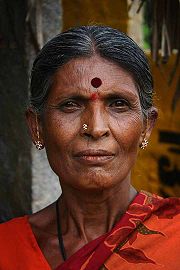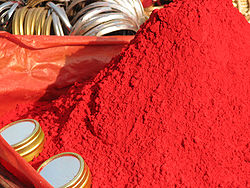
Tilaka
Encyclopedia

Hinduism
Hinduism is the predominant and indigenous religious tradition of the Indian Subcontinent. Hinduism is known to its followers as , amongst many other expressions...
, the tilaka or tika or tilak ( ; t̪ɪˈlək tilak) is a mark worn on the forehead and other parts of the body. Tilaka may be worn on a daily basis or for special religious occasions only, depending on different customs.
Significance of tilaka
The tilaka symbolizes the third eye, or mind's eye, associated with many Hindu gods, and the idea of meditation and spiritual enlightenment. In the past, tilakas were usually worn by gods, priests, ascetics, or worshippers, but is now a common practice for most Hindus. It can express which Hindu tradition one follows. It may be made with sandalwoodSandalwood
Sandalwood is the name of a class of fragrant woods from trees in the genus Santalum. The woods are heavy, yellow, and fine-grained, and unlike many other aromatic woods they retain their fragrance for decades. As well as using the harvested and cut wood in-situ, essential oils are also extracted...
paste, ashes (vibhuti
Vibhuti
Vibhuti is a word that has several meanings in Hinduism.-Sacred ash:Vibhuti is the sacred ash used in religious worship in Hinduism. The main ingredient of Vibuthi is a special kind of wood, but several other substances, such as milk and ghee, prescribed in scriptures are also added...
), kumkum
Kumkum
Kumkum , is a powder used for social and religious markings in Hinduism. It is either made from turmeric or saffron...
, sindhoor, clay, or other substances. The pastes are applied to the forehead and in some cases to the upper part of the head.
History and evolution of the tilak
The tilak is a mark created by the smearing of powder or paste on the forehead. Occasionally it extends vertically and horizontally on a large part of the forehead and may cover the nose also. The most conspicuous and widespread are those worn by Vaishnavites or followers of Lord VishnuVishnu
Vishnu is the Supreme god in the Vaishnavite tradition of Hinduism. Smarta followers of Adi Shankara, among others, venerate Vishnu as one of the five primary forms of God....
and his so-called incarnations, chiefly Lord Krishna
Krishna
Krishna is a central figure of Hinduism and is traditionally attributed the authorship of the Bhagavad Gita. He is the supreme Being and considered in some monotheistic traditions as an Avatar of Vishnu...
. The tilak consists of a long line starting from just below the hairline till almost the end of one's nose tip. It is intercepted in the middle by an elongated U. There may be two marks on the temples as well. This tilak is traditionally done with sandalwood paste, lauded in Hindu texts for its purity and cooling nature.
The other major tilak variant is often worn by the followers of Lord Shiva
Shiva
Shiva is a major Hindu deity, and is the destroyer god or transformer among the Trimurti, the Hindu Trinity of the primary aspects of the divine. God Shiva is a yogi who has notice of everything that happens in the world and is the main aspect of life. Yet one with great power lives a life of a...
and the different forms of Devi Shakti
Shakti
Shakti from Sanskrit shak - "to be able," meaning sacred force or empowerment, is the primordial cosmic energy and represents the dynamic forces that are thought to move through the entire universe in Hinduism. Shakti is the concept, or personification, of divine feminine creative power, sometimes...
. It consists of three horizontal bands across the forehead with a single vertical band or circle in the middle. This is traditionally done with the ash or bhasma of the wood used in yagnyas to propitiate Lord Shiva or Devi Shakti. This variant is the more ancient of the two and shares many common aspect with similar markings worn across the world. Many worshippers of Goddess Shakti will wear a rectangular mark of kumkum on the forehead, especially South Indians or those of South Indian descent.
Nowadays, many Hindus do not wear the tilak in everyday life. Women consider it an old tradition that doesn't suit their western clothing, but many Hindu women do wear the Bindi
Bindi
-People:* Bindi Irwin, daughter of wildlife conservationist Steve Irwin** Bindi the Jungle Girl , Bindi Irwin's TV show* Rosy Bindi, Italian politician* Giacomo Bindi* Umberto Bindi, Italian singer-songwriter* Emanuele Bindi, Italian bicycle racer...
. The tilak is often worn on religious occasions and on auspicious days (birthdays, weddings, etc.) or after marriage.
Tilak based upon caste system
Based upon the Hindu caste system and vedic texts, there are four types of tilaka:- Brahman tilak - Urdhapundra - marking of two vertical lines on forehead (now it is more of a U-shaped tilak.)
- Kshatriya tilak - TripundraTripundraTripundra or பட்டை / Pattai in Tamil is a saivite tilaka. 'Tripundra' refers to the three mukti. tri means three, pundra means one which is released. There are three horizontal lines of vibhuti on the brow, often with a dot as the third eye. The three lines represent the soul's three bonds:...
- three arc-like vertical lines on the forehead with a circular mark on top of it - Vaishya tilak - Ardhachandra - half moon tilak, with a bindi or circular mark in middle of the half arc
- Shudra tilak - Partal - large circular mark on forehead
Terminology

In Nepal
Nepal
Nepal , officially the Federal Democratic Republic of Nepal, is a landlocked sovereign state located in South Asia. It is located in the Himalayas and bordered to the north by the People's Republic of China, and to the south, east, and west by the Republic of India...
, Bihar
Bihar
Bihar is a state in eastern India. It is the 12th largest state in terms of geographical size at and 3rd largest by population. Almost 58% of Biharis are below the age of 25, which is the highest proportion in India....
and other regions, the tilak is called a tikā/teeka (टिका ʈɪkaː), and is a mixture of abir
Abir
Abir is a dye common in India. It is used during the Holi festival, which is also called the festival of colour, when people throw this colourful powder at each other. Abir is typically sold in markets prior to the festival....
, a red powder, yoghurt, and grains of rice. The most common tikka is red powder applied with the thumb, in a single upward stroke.
Tilaka based on sect
Different Hindu traditions use different materials and shapes to make the tilaka .- Saivites typically use vibhuti in three horizontal lines across the forehead. A binduBinduBindu is a Sanskrit term meaning "point" or "dot". The feminine case ending is bindi which denotes a small ornamental, devotional and/or mystical dot that is cosmetically applied or affixed to the forehead in Hinduism....
of sandalwood paste with a dot of kumkum in the centre is often worn with the vibhuti (tripundraTripundraTripundra or பட்டை / Pattai in Tamil is a saivite tilaka. 'Tripundra' refers to the three mukti. tri means three, pundra means one which is released. There are three horizontal lines of vibhuti on the brow, often with a dot as the third eye. The three lines represent the soul's three bonds:...
). - Vaishnavas apply clay from a holy river or place (such as VrindavanVrindavanVrindavan also known as Vraj is a town in the Mathura district of Uttar Pradesh, India...
or the YamunaYamunaThe Yamuna is the largest tributary river of the Ganges in northern India...
river) which is sometimes mixed with sandalwood paste. They apply the material in two vertical lines, which may be connected at the bottom, forming either a simple U shape or with an additional marking in the shape of a tulsiTulsiOcimum tenuiflorum Ocimum tenuiflorum Ocimum tenuiflorum (also tulsi, tulasī, or Holy Basil is an aromatic plant in the family Lamiaceae which is native throughout the Old World tropics and widespread as a cultivated plant and an escaped weed. It is an erect, much branched subshrub 30–60 cm...
leaf. Their tilaka is called the Urdhva Pundra tilakUrdhva Pundra TilakUrdhva Pundra tilak or Udharva Marka is a yellow U mark on the forehead made with chandan and a red dot in the centre usually made out of kumkum worn by members of the Swaminarayan Sampraday. The yellow U mark signifies the Swaminarayan's feet, while the red dot signifies Lakshmi. Urdhva Pundra...
. - GanapatyaGanapatyaGanapatya is a denomination of Hinduism that worships Ganesha as the Saguna Brahman.The worship of Ganesha is considered complementary with the worship of other deities. Hindus of all sects begin prayers, important undertakings, and religious ceremonies with an invocation of Ganesha...
use red sandal paste (rakta candana). - Shaktas use kumkuma, or powdered red turmericTurmericTurmeric is a rhizomatous herbaceous perennial plant of the ginger family, Zingiberaceae. It is native to tropical South Asia and needs temperatures between 20 °C and 30 °C and a considerable amount of annual rainfall to thrive...
. They draw one vertical line or dot. - Honorary tilakas (Raj tilak and Vir tilak are usually applied as a single vertical red line. Raj tilak will be used while throning kings or inviting prominent personalities. Vir tilak is used to anoint victors or leaders after a war or a game.
- Swaminarayan tilak is U-shaped in the middle of forehead along with the red dot in the middle of U (known as chandlo).
Types of tilak
There are nineteen types of tilak:.- Vijayshree - white tilak urdhwapundra with a white line in the middle, founded by Swami Balanand of Jaipur
- Bendi tilak - white tilak urdhwapundra with a white round mark in the middle, founded by Swami Ramprasad Acharya of Badasthan Ayodhya.
- Chaturbhuji tilak - white tilak urdhwapundra with the upper portion turned 90 degrees in the opposite direction, no shri in the middle, founded by Narayandasji of Bihar, ascetics of Swarg Dwar of Ayodhya follow it.
Other tilaks
These include 12 Sri Tilaks- Sri Tilak of Rewasa Gaddi
- Ramcharandas Tilak
- Srijiwaram ka Tilak
- Sri Janakraj Kishori Sharan Rasik Aliji ka Tilak
- Sri Rupkalajee ka Tilak
- Rupsarasji ka Tilak
- Ramsakheeji ka Tilak
- Kamnendu Mani ka Tilak
- Karunsindhuji ka Tilak
- Swaminarayan Tilak
- Nimbark ka Tilak
- Madhwa ka Tilak
Relationship to bindi
The terms tilaka and bindiBindi (decoration)
A bindi is a forehead decoration worn in South Asia . and Southeast Asia...
overlap somewhat, but are definitely not synonymous. Among the differences:
- A tilaka is always applied with paste or powder, whereas a bindi may be paste, a sticker, or even jewelry.
- A tilaka can be worn by both sexes, whereas a bindi is worn only by women.
- A tilaka is usually applied for religious or spiritual reasons, or to honor a personage, event, or victory. A bindi can signify marriage, or be simply for decorative purposes.
- A bindi is worn only between the eyes, whereas a tilaka can also cover the face or other parts of the body. Tilak can be applied to twelve parts of the body: head, forehead, neck, both upper-arms, both forearms, chest, both sides of the torso, stomach and shoulder.
- Bindi is a Hindi term, whereas tilaka applies to the entire Indian subcontinent.
Different styles
Red tikka marks are traditionally used in wedding ceremonies as well as in everyday life.Further reading
- Mittal, Sushil; Thursby, Gene R. (2006). Religions of South Asia: An Introduction. Taylor & Francis, United Kingdom. ISBN 0415223903. pp. 73.

